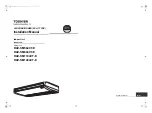
– 8 –
Ceiling Type
Installation Manual
EN
Ceiling Type
Installation Manual
<There is no ceiling material>
Holding down of main unit
1
Attach washer and nuts to the hanging bolt.
2
Hang the unit to the hanging bolt as shown
the figure below.
3
As shown in the figure below, fix the ceiling
material securely with the double nuts.
REQUIREMENT
• The ceiling surface may not be horizontal. Confirm
that width and depth directions are level.
• Do not lower the air discharge side and the side
opposite to the selected drain pipe withdraw.
Installation of remote
controller (Sold separately)
For installation of the remote controller, follow the
Installation Manual attached with the remote controller.
• Pull out the remote controller cord together with the
refrigerant pipe or drain pipe.
Pass the remote controller cord through upper side
of the refrigerant pipe and drain pipe.
• Do not leave the remote controller at a place
exposed to the direct sunlight and near a stove.
• Operate the remote controller, confirm that the
indoor unit receives a signal surely, and then install
it. (Wireless type)
• Keep 1 m or more from the devices such as
television, stereo.
(Disturbance of image or noise may generate.)
(Wireless type)
Indoor
unit
Hanging bolt
(Procured locally)
Washer
(Procured locally)
Washer (Accessory)
Double nut
(Procured locally)
20 to 30
Ceiling surface
Washer
(Accessory)
Double nut
(Procured locally)
Hanging bolt
5
Drain Piping
CAUTION
Following the Installation Manual, perform the drain piping work so that water is properly drained. Apply a heat
insulation so as not to cause a dew condensation.
Inappropriate piping work may result in water leakage in the room and wet furniture.
• Provide the indoor drain piping with proper heat insulation.
• Provide the area where the pipe connects to the indoor unit with proper heat insulation. Improper heat insulation
will cause condensation to form.
• The drain pipe must be sloping downward (at an angle of 1/100 or more), and do not run the pipe up and down
(arched shape) or allow it to form traps. Doing so may cause abnormal sounds.
• Restrict the length of the traversing drain pipe to 20 meters or less. For a long pipe, provide support brackets at
intervals of 1.5 to 2 meters to prevent flapping.
• Install the collective piping as shown in the following figure.
• Do not provide any air vents. Otherwise, the drain water will spout, causing water to leak.
• Do not allow any force to be applied to the connection area with the drain pipe.
• A hard PVC pipe cannot be connected to the drain pipe connecting port of the indoor unit. Be absolutely sure to
use the flexible hose provided for the connections with the drain pipe connecting port.
• Adhesive agents cannot be used for the drain pipe connecting port (herd socket) of the indoor unit. Be absolutely
sure to secure the pipe using the hose bands provided. Use of an adhesive agent may damage the drain pipe
connecting port or cause water to leak.
Pipe material, size and insulator
The following materials for piping work and insulating process are procured locally.
Pipe material
Hard vinyl chloride pipe VP20 (Nominal outer diameter Ø26 mm)
Insulator
Foamed polyethylene foam, thickness: 10 mm or more
1.5 m to 2 m
Support
bracket
Downward slope
1/100 or more
Arched shape
Trap
Downward slope
1/100 or more
(Collective
piping)
As long as possible
(Approx. 10 cm)
Heat
insulator
Incorrect
VP30
Drain pipe
connecting port
(hard socket)
Attached
hose band
Attached drain hose
Attached hose band
Adhesive
agent
prohibited
VP 20 Polyvinyl
chloride pipe
(locally procured)
Dr
ai
n p
an
Soft
socket
Soft
socket
15-EN
16-EN
+00EH99878901_01EN.book Page 8 Wednesday, April 13, 2011 9:38 AM






















